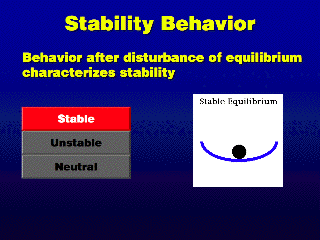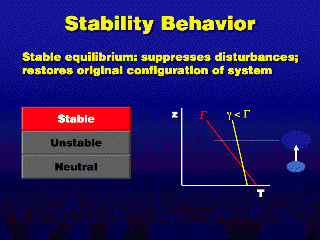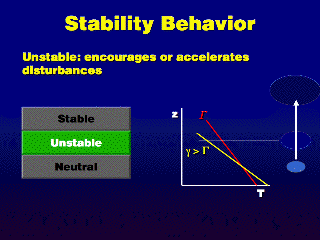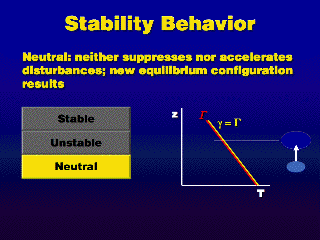 The atmosphere is usually in some state of equilibrium. This equilibrium
can exist as three different states, depending on what happens after we
try to disturb (or perturb) this equilibrium.
The atmosphere is usually in some state of equilibrium. This equilibrium
can exist as three different states, depending on what happens after we
try to disturb (or perturb) this equilibrium. The atmosphere is usually in some state of equilibrium. This equilibrium
can exist as three different states, depending on what happens after we
try to disturb (or perturb) this equilibrium.
The atmosphere is usually in some state of equilibrium. This equilibrium
can exist as three different states, depending on what happens after we
try to disturb (or perturb) this equilibrium.
 |
 |
If we disturb the equilibrium, and the system restores itself back to the original equilibrium configuration (through some restoring force, usually gravity), then we say this equilibrium is stable. The ball, in equilibrium at the bottom of the bowl, returns to this position due to a restoring gravitational force if it is nudged upward. See also the QuickTime movie of a stable system. A stable system resists changes. If the atmosphere is stable, then changes to the vertical configuration (the distribution of pollutants) is resisted or inhibited. |
When the environmental lapse rate is less than the adiabatic lapse rate, the temperature in a rising air parcel (that is adiabatically expanding) will decrease at a faster rate than the temperature in the surrounding air. An air parcel that starts at the same temperature as the surrounding will then become colder than the surrounding air if it rises. This makes the air parcel negatively buoyant, and it sinks back down until its temperature is the same as the environmental temperature; the temperature increases at the same rate as it lost temperature, so it ends up at the same altitude as when it started. This demonstrates stable behavior--the vertical motion of the air parcel is suppressed. |
 |
 |
If we disturb the equilibrium, and the system accelerates away from the original equilibrium condition, not coming back, then we say this equilibrium is unstable. The ball, balanced an in equilibrium on top of the inverted bowl, rolls away if we nudged it off this balance point. See also the QuickTime movie of an unstable system. Unstable systems are easy to bump into a non-equilibrium state, so change seems to be encouraged. An unstable atmosphere will tend to produce vertical, convective dispersion. |
When the environmental lapse rate is greater than the adiabatic lapse rate, the environment loses temperature faster than a rising air parcel. If an air parcel starts out with the same temperature as the environment, then is pushed upward (so it adiabatically expands), its temperature will go down to a lesser extent than the surrounding air, so the parcel temperature will be higher than the temperature of the surrounding air. The air parcel will be warmer than its surroundings and thus positively buoyant, and will continue to rise by itself. This behavior, where the disturbance caused the system to accelerate away from equilibrium, demonstrates a case of unstable equilibrium. |
 |
 |
If we disturb the equilibrium, and the system stays in a new equilibrium configuration but not the original one, then we say this equilibrium is neutral. The ball on the level table stays wherever we move it. It does not come back, but it does not roll away either. See also the QuickTime movie of a neutral system. Changes are neither resisted nor enhanced in a system with neutral
stability. Atmospheres that are neutral do not resist vertical re-configuration,
but it is not encouraged as in the unstable case; thus some convective dispersion
takes place at a relatively slow rate, mainly due to random, turbulent air
motions. |
When the environmental lapse rate is equal to the adiabatic lapse rate, a rising air parcel loses temperature at the same rate as the environment. In the case above, the air parcel starts at the same temperature as the environment. When the parcel is forced upward, the temperature inside decreases (from adiabatic expansion), but the environmental temperature decreases at the same rate, so the parcel temperature and the environmental temperature are still equal to each other. The air parcel will stay at its new altitude, still in equilibrium with the environment but not in its original position. This behavior, where the displaced parcel stays wherever it is moved, indicates neutral stability. |